Abstract
Sulfur is an important key nutrient required for the growth and development of cyanobacteria. Several reports showed the effect of sulfate limitation in unicellular and filamentous cyanobacteria, but such studies have not yet been reported in heterocytous cyanobacteria to ascribe the mechanisms of nitrogen and thiol metabolisms. Thus, the present work was carried out to appraise the impacts of sulfate limitation on nitrogen and thiol metabolisms in Anabaena sp. PCC 7120 by analyzing the contents as well as enzymes of nitrogen and thiol metabolisms. Cells of Anabaena sp. PCC 7120 were exposed to different regimes of sulfate, i.e., 300, 30, 3, and 0 µM. Application of reduced concentration of sulfate showed negative impact on the cyanobacterium. Sulfate-limiting conditions reduces nitrogen-containing compounds in the cells of Anabaena. Additionally, reduced activities of nitrogen metabolic enzymes represented the role of sulfate in nitrogen metabolism. However, decreased activities of thiol metabolic enzymes indicated that sulfate-limited cyanobacterial cells have lower amount of glutathione and total thiol contents. Reduced accumulation of thiol components in the stressed cells indicated that sulfate-limited cells have lower ability to withstand stressful condition. Hence, Anabaena displays differential response to different concentrations of sulfate, and thus, stipulated that sulfur plays an important role in nitrogen and thiol metabolisms. To the best of our knowledge, this is the first report demonstrating the impact of sulfate stress on nitrogen and redox metabolisms in heterocytous cyanobacteria. This preliminary study provides a baseline idea that may help improve the production of paddy.





Similar content being viewed by others
Data Availability
The datasets of the present study are available from the authors.
Code Availability
Not applicable.
Abbreviations
- APR:
-
APS-reductase
- APS:
-
Adenosine-5’-phopsphosulfate
- ATPS:
-
ATP sulfurylase
- DO:
-
Degree of oxidation
- FAO:
-
Food and agriculture organization
- GPX:
-
Glutathione peroxidase
- GR:
-
Glutathione reductase
- GSH:
-
Reduced glutathione
- GSSG:
-
Oxidized glutathione
- NiR:
-
Nitrite reductase
- NR:
-
Nitrate reductase
- OAS-TL:
-
O-acetyl serine (thiol) lyase
- SAT:
-
Serine acetyltransferase
- γ-GCS:
-
γ-Glutamyl cysteine synthetase
References
FAO (2020) Statistics database. Accessed 10 Feb 2020 http://faostat.fao.org.
Kharwar S, Bhattacharjee S, Chakraborty S, Mishra AK (2021) Regulation of sulfur metabolism, homeostasis and adaptive responses to sulfur limitation in cyanobacteria. Biologia 76(10):2811–2835. https://doi.org/10.1007/s11756-021-00819-5
Kharwar S, Mishra AK (2020) Unravelling the complexities underlying sulfur deficiency and starvation in the cyanobacterium Anabaena sp. PCC 7120. Environ Exp Bot 172:103966. https://doi.org/10.1016/j.envexpbot.2019.103966
Kharwar S, Bhattacharjee S, Mishra AK (2021) Bioinformatics analysis of enzymes involved in cysteine biosynthesis: first evidence for the formation of cysteine synthase complex in cyanobacteria. 3 Biotech. https://doi.org/10.1007/s13205-021-02899-1
Prasad RC, Prasad BN (2001) Cyanobacteria as a source biofertilizer for sustainable agriculture in Nepal. J Plant Sci Bot Orient 1:127–133. https://doi.org/10.1016/j.bbrep.2020.100737
Lunde C, Zygadlo A, Simonsen HT, Nielsen PL, Blennow A, Haldrup A (2008) Sulfur starvation in rice: the effect on photosynthesis, carbohydrate metabolism, and oxidative stress protective pathways. Physiol Plant 134(3):508–521. https://doi.org/10.1111/j.1399-3054.2008.01159.x
Resurreccion AP, Makino A, Bennett J, Mae T (2002) Effect of light intensity on the growth and photosynthesis of rice under different sulfur concentrations. Soil Sci Plant Nutr 48:71–77. https://doi.org/10.1080/00380768.2002.10409173
Kolesinski P, Rydzy M, Szczepaniak A (2017) Is RAF1 protein from Synechocystis sp. PCC 6803 really needed in the cyanobacterial Rubisco assembly process. Photosynth Res 132(2):135–148. https://doi.org/10.1007/s11120-017-0336-4
Kumaresan V, Nizam F, Ravichandran G, Viswanathan K, Palanisamy R, Bhatt P, Arasu MV, Al-Dhabi NA, Mala K, Arockiaraj J (2017) Transcriptome changes of blue-green algae, Arthrospira sp. in response to sulfate stress. Algal Res 23:96–103. https://doi.org/10.1016/j.algal.2017.01.012
Green LS, Grossman AR (1988) Changes in sulfate transport characteristics and protein composition of Anacystis nidulans R2 during sulfur deprivation. J Bacteriol 170(2):583–587. https://doi.org/10.1128/jb.170.2.583-587
Hifney AF, Abdel-Basset R (2014) Induction of hydrogen evolution in Nostoc spp. by nitrogen and/or sulphur deficiency. Int J Curr Microbiol App Sci 3(9):1028–1044
Ortega-Calvo J, Stal LJ (1994) Sulphate-limited growth in the N2-fixing unicellular cyanobacterium Gloeothece (Nägeli) sp. PCC 6909. New Phytol 128(2):273–281. https://doi.org/10.1111/j.1469-8137.1994.tb04011.x
Patterson K, Cakmak T, Cooper A, Lager IDA, Rasmusson AG, Escobar MA (2010) Distinct signalling pathways and transcriptome response signatures differentiate ammonium-and nitrate-supplied plants. Plant Cell Environ 33(9):1486–1501. https://doi.org/10.1111/j.1365-3040.2010.02158.x
Ogawa K, Shiraishi N, Ida S, Nakagawa H, Komamine A (1999) Effects of glutamine on the induction of nitrate reductase and nitrite reductase in cultured spinach cells. J Plant Physiol 154(1):46–50. https://doi.org/10.1016/S0176-1617(99)80316-2
Molins-Legua C, Meseguer-Lloret S, Moliner-Martinez Y, Campíns-Falcó P (2006) A guide for selecting the most appropriate method for ammonium determination in water analysis. Trends Anal Chem 25(3):282–290. https://doi.org/10.1016/j.trac.2005.12.002
Herrero AN, Flores EN, Guerrero MG (1981) Regulation of nitrate reductase levels in the cyanobacteria Anacystis nidulans, Anabaena sp. strain 7119, and Nostoc sp. strain 6719. Bacteriol 145(1):175–180. https://doi.org/10.1128/jb.145.1.175-180.1981
Herrero A, Guerrero MG (1986) Regulation of nitrite reductase in the cyanobacterium Anacystis nidulans. Microbiol 132(9):2463–2468. https://doi.org/10.1128/jb.145.1.175-180.1981
Shapiro BM, Stadtman ER (1970) [130] Glutamine synthetase (Escherichia coli). In Methods in enzymology, Academic Press, 910–922 https://doi.org/10.1016/0076-6879(71)17305-3
Sedlak J, Lindsay RH (1968) Estimation of total, protein-bound, and nonprotein sulfhydryl groups in tissue with Ellman’s reagent. Anal Biochem 25:192–205. https://doi.org/10.1016/0003-2697(68)90092-4
Anderson ME (1985) Determination of glutathione and glutathione disulfide in biological samples. In Methods in enzymology. Academic Press, 113:548-555 https://doi.org/10.1016/s0076-6879(85)13073-9
Nakamura K, Hayama A, Masada M, Fukushima K, Tamura G (1987) Measurement of serine acetyltransferase activity in crude plant extracts by a coupled assay system using cysteine synthase. Plant Cell Physio 28(5):885–891. https://doi.org/10.1093/oxfordjournals.pcp.a077370
Orlowski M, Meister A (1971) Partial reactions catalyzed by γ-glutamylcysteine synthetase and evidence for an activated glutamate intermediate. J Biol Chem 246(23):7095–7105. https://doi.org/10.1016/S0021-9258(19)45858-4
Schaedle M, Bassham JA (1977) Chloroplast glutathione reductase. Plant Physio 59(5):1011–1012. https://doi.org/10.1104/pp.59.5.1011
Lawrence RA, Burk RF (1976) Glutathione peroxidase activity in selenium-deficient rat liver. Biochem Biophys Res Commun 71(4):952–958. https://doi.org/10.1016/0006-291x(76)90747-6
Flores E, Herrero A (1994) Assimilatory nitrogen metabolism and its regulation. In The molecular biology of cyanobacteria Springer, Dordrecht, 487–517 https://doi.org/10.1007/978-94-011-0227-8_16
Rai LC, Tyagi B, Mallick N, Rai PK (1995) Interactive effects of UV-B and copper on photosynthetic activity of the cyanobacterium Anabaena doliolum. Environ Exp Bot 35(2):177–185. https://doi.org/10.1016/0098-8472(94)00046-8
Ohashi Y, Shi W, Takatani N, Aichi M, Maeda SI, Watanabe S, Yoshikawa H, Omata T (2011) Regulation of nitrate assimilation in cyanobacteria. J Exp Bot 62(4):1411–1424. https://doi.org/10.1093/jxb/erq427
Singh VP, Srivastava PK, Prasad SM (2012) UV-B induced differential effect on growth and nitrogen metabolism in two cyanobacteria under copper toxicity. Cell Mol Biol 58(1):85–95. https://doi.org/10.1170/T925
Sheeba RK, Prasad SM (2020) Nostoc muscorum and Phormidium foveolarum differentially respond to butachlor and UV-B stress. Physio Mol Biol Plants 26(4):841–856. https://doi.org/10.1007/s12298-019-00754-5
Nagalakshmi N, Prasad MNV (2001) Responses of glutathione cycle enzymes and glutathione metabolism to copper stress in Scenedesmus bijugatus. Plant Sci 160:291–299. https://doi.org/10.1016/s0168-9452(00)00392-7
Yadav P, Singh RP, Gupta RK (2022) Role of cyanobacteria in germination and growth of paddy seedlings. Int J Phytol Res 2:11–18
Wang Z, Li D, Li G, Liu Y (2010) Mechanism of photosynthetic response in Microcystis aeruginosa PCC7806 to low inorganic phosphorus. Harmful Algae 9:613–619. https://doi.org/10.1016/j.hal.2010.04.012
Blindauer CA (2011) Bacterial metallothioneins: past, present, and questions for the future. J Biol Inorg Chem 16:1011–1024. https://doi.org/10.1007/s00775-011-0790-y
Apte SK, Reddy BR, Thomas J (1987) Relationship between sodium influx and salt tolerance of nitrogen-fixing cyanobacteria. Appl Environ Microbiol 53:1934–1939. https://doi.org/10.1128/aem.53.8.1934-1939.1987
Cameron JC, Pakrasi HB (2010) Essential role of glutathione in acclimation to environmental and redox perturbations in the cyanobacterium Synechocystis sp. PCC 6803. Plant Physiol 154(4):1672–1685. https://doi.org/10.1104/pp.110.162990
Schafer FQ, Buettner GR (2001) Redox environment of the cell as viewed through the redox state of the glutathione disulfide/glutathione couple. Free Radic Biol Med 30(11):1191–1212. https://doi.org/10.1016/s0891-5849(01)00480-4
Arrigo AP (1999) Gene expression and the thiol redox state. Free Radic Biol Med 27(9–10):936–944. https://doi.org/10.1016/s0891-5849(99)00175-6
Voehringer DW (1999) BCL-2 and glutathione: alterations in cellular redox state that regulate apoptosis sensitivity. Free Radic Biol Med 27(9–10):945–950. https://doi.org/10.1016/s0891-5849(99)00174-4
Li M, Yang Q, Zhang L, Li H, Cui Y, Wu Q (2007) Identification of novel targets of cyanobacterial glutaredoxin. Arch Biochem Biophys 458:220–228. https://doi.org/10.1016/j.abb.2006.12.010
Zechmann B, Tomašić A, Horvat L, Fulgosi H (2010) Subcellular distribution of glutathione and cysteine in cyanobacteria. Protoplasma 246(1):65–72. https://doi.org/10.1007/s00709-010-0126-8
Adams JD Jr, Klaidman LK, Chang ML, Yang J (2001) Brain oxidative stress—analytical chemistry and thermodynamics of glutathione and NADPH. Curr Top Med Chem 1:473–482. https://doi.org/10.2174/1568026013394778
Noji M, Saito K (2002) Molecular and biochemical analysis of serine acetyltransferase and cysteine synthase towards sulfur metabolic engineering in plants. Amino Acids 22(3):231–243. https://doi.org/10.1007/s007260200011
Elskens MT, Jaspers CJ, Penninckx MJ (1991) Glutathione as an endogenous sulphur source in the yeast Saccharomyces cerevisiae. J Gen Microbiol 137:637–644. https://doi.org/10.1099/00221287-137-3-637
Mehdi K, Penninckx MJ (1997) An important role for glutathione and gamma-glutamyltranspeptidase in the supply of growth requirements during nitrogen starvation of the yeast Saccharomyces cerevisiae. Microbiol 143:1885–1889. https://doi.org/10.1099/00221287-143-6-1885
Nikiforova VJ, Kopka J, Tolstikov V, Fiehn O, Hopkins L, Hawkesford MJ, Hesse H, Hoefgen R (2005) Systems rebalancing of metabolism in response to sulfur deprivation, as revealed by metabolome analysis of Arabidopsis plants. Plant Physiol 138:304–318. https://doi.org/10.1104/pp.104.053793
Couto N, Wood J, Barber J (2016) The role of glutathione reductase and related enzymes on cellular redox homoeostasis network. Free Radic Biol Med 95:27–42. https://doi.org/10.1016/j.freeradbiomed.2016.02.028
Zhang J, Hao H, Wu X, Wang Q, Chen M, Feng Z, Chen H (2020) The functions of glutathione peroxidase in ROS homeostasis and fruiting body development in Hypsizygus marmoreus. Appl Microbiol Biotech 104(24):10555–10570. https://doi.org/10.1007/s00253-020-10981-6
Donker VA, Hader DP (1997) Ultraviolet radiation effects on pigmentation in the cyanobacterium Phormidium uncinatum. Acta Protozool 36:49–55
Yadav P, Singh RP, Rana S, Joshi D, Kumar D, Bhardwaj N, Gupta RK, Kumar A (2022) Mechanisms of stress tolerance in cyanobacteria under extreme conditions. Stresses 2(4):531–549. https://doi.org/10.3390/stresses2040036
Acknowledgements
Authors are thankful to the Head, Department of Botany, Banaras Hindu University for the necessary lab and instrument facilities. Surbhi Kharwar is thankful to University Grant Commission, New Delhi, for financial support in the form of Junior and Senior research fellowships.
Funding
This work was supported by the University Grant Commission, New Delhi, and Institute of Eminence (IoE-6031), Banaras Hindu University, Varanasi.
Author information
Authors and Affiliations
Contributions
SK: performed the experiments, statistical analysis, and wrote the manuscript. AKM: reviewed the manuscript. The authors read, reviewed, and approved the manuscript.
Corresponding author
Ethics declarations
Conflict of interest
Authors declared they have no conflict of interest.
Ethical Approval
Not applicable.
Consent to Participations
Not applicable.
Consent for Publications
Not applicable.
Additional information
Publisher's Note
Springer Nature remains neutral with regard to jurisdictional claims in published maps and institutional affiliations.
Rights and permissions
Springer Nature or its licensor (e.g. a society or other partner) holds exclusive rights to this article under a publishing agreement with the author(s) or other rightsholder(s); author self-archiving of the accepted manuscript version of this article is solely governed by the terms of such publishing agreement and applicable law.
About this article
Cite this article
Kharwar, S., Mishra, A.K. Nitrogen and Redox Metabolism in Cyanobacterium Anabaena sp. PCC 7120 Exposed to Different Sulfate Regimes. Curr Microbiol 80, 265 (2023). https://doi.org/10.1007/s00284-023-03374-1
Received:
Accepted:
Published:
DOI: https://doi.org/10.1007/s00284-023-03374-1




